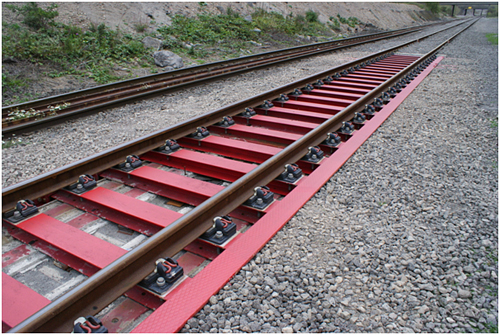€15 million project to revolutionise railway tracks
Thu, 17 Oct 2013 13:29:00 BST
Institute of Railway Research to play key role in the CAPACITY4RAIL project to develop modular, all-steel track sections embedded with fibre optics

Pictured: Innovative steel-track construction prototype by Tata-Steel, on which the Institute of Railway Research was closely involved, developed from the EU-backed INNOTRACK project.
SINCE the advent of railways in the 1800s, tracks have been laid by fixing individual rails to individual sleepers on a bed of ballast. Now, a team of University of Huddersfield researchers is to break with tradition and work on the development of modular, all-steel track sections that can be laid quickly and embedded with fibre optic technology, which provides instant safety alerts. This could lead to massive cost savings and gains in efficiency.
 The Institute of Railway Research (IRR), headed by Professor Simon Iwnicki, is based at the University and is one of the partners in a 15 million euro, four-year project funded by the European Union under its Seventh Framework Programme. Named CAPACITY4RAIL, the ambitious scheme aims to ensure that railways will continue to meet Europe’s transport needs over the decades to come. Low maintenance infrastructure, more resilient and easily repairable points – or switches – and higher-speed freight vehicles are among the goals.
The Institute of Railway Research (IRR), headed by Professor Simon Iwnicki, is based at the University and is one of the partners in a 15 million euro, four-year project funded by the European Union under its Seventh Framework Programme. Named CAPACITY4RAIL, the ambitious scheme aims to ensure that railways will continue to meet Europe’s transport needs over the decades to come. Low maintenance infrastructure, more resilient and easily repairable points – or switches – and higher-speed freight vehicles are among the goals.
There are 47 partners – including major technology companies and European universities – and the University of Huddersfield’s IRR concentrates on a work package entitled “modular integrated design of new concepts for infrastructure”. One of the IRR’s tasks will be to help in the development and design requirements of new track systems. The Institute’s Head of Research, Dr Yann Bezin, said: “We will be looking at more efficient designs and methods of building a track, in a modular way rather than by laying down ballast layers and then individual sleepers and putting the rails on top. That takes a long time and requires very expensive and heavy machinery. Modular concepts allow track to be brought pre-assembled in sections for a quick installation.
 “A big problem is vertical support of the track,” explained Dr Bezin. “Currently you get deterioration from one sleeper to the other or the ballast degrades and some sleepers become unsupported. A concrete sleeper is the norm, but we have studied a steel track system that uses steel beams. This gives consistency of support and better control of dynamic forces.”
“A big problem is vertical support of the track,” explained Dr Bezin. “Currently you get deterioration from one sleeper to the other or the ballast degrades and some sleepers become unsupported. A concrete sleeper is the norm, but we have studied a steel track system that uses steel beams. This gives consistency of support and better control of dynamic forces.”
Dr Bezin added that the construction of modular track sections in the factory would mean that they could be pre-equipped with smart technology.
“We could make the track system intelligent. Fibre optics running along the rail would enable you to know from the signal whether or not there is an unusual deformation, an indication of fatigue cracking or some other problem”.
This condition monitoring system would make maintenance a much simpler process, adding to the efficiency gains from modular track construction.
CAPACITY4RAIL
The IRR will receive more than 470,000 euros for its contribution to CAPACITY4RAIL. In addition to work on modular track sections, the Institute’s researchers, who are based in specially-equipped labs at the University of Huddersfield, will study new designs for the construction of switches and crossings – complex elements of the rail network that are the most vulnerable to wear and damage.
 The IRR will be investigating resilient new materials for crossings and switches, working with the metallurgist Jay Jaiswal, formerly of Tata Steel, who has been appointed a visiting professor at the University of Huddersfield.
The IRR will be investigating resilient new materials for crossings and switches, working with the metallurgist Jay Jaiswal, formerly of Tata Steel, who has been appointed a visiting professor at the University of Huddersfield.
The Institute will also be working with major companies such as SYSTRA, which has constructed all of France’s and half of the world’s high speed lines. And the CAPACITY4RAIL research will build on the findings of previous projects that the IRR has been closely involved with, such as the EU-backed INNOTRACK, which has investigated many of the technical challenges posed by the European Commission’s goal of doubling rail passenger traffic and tripling freight traffic by 2020.
CAPACITY4RAIL is to be launched at a meeting in Paris, attended by all of the partners. Ahead of this, the IRR will be holding a special brainstorming session at the University of Huddersfield, so that its researchers can develop the details of their contribution to the project.







